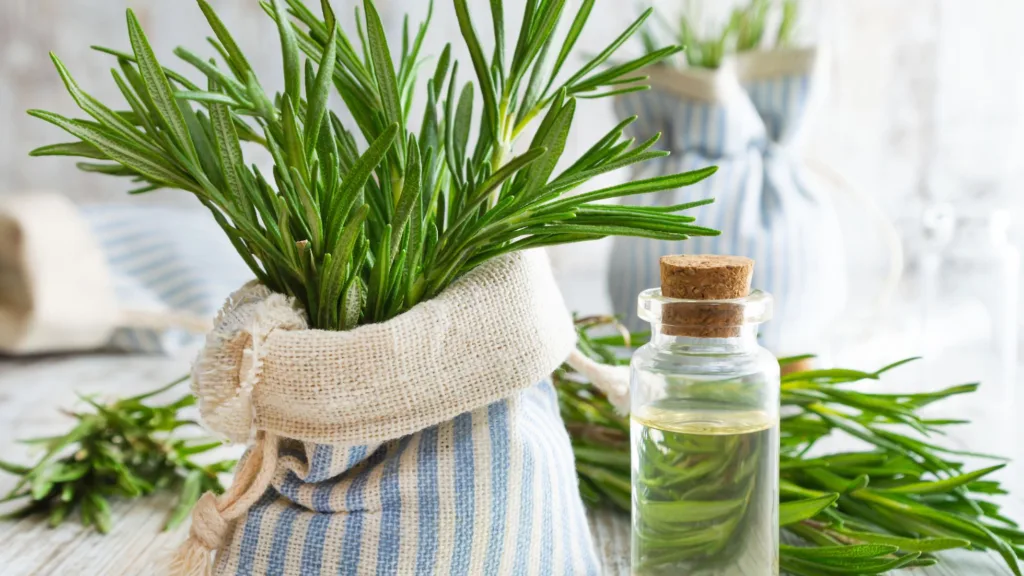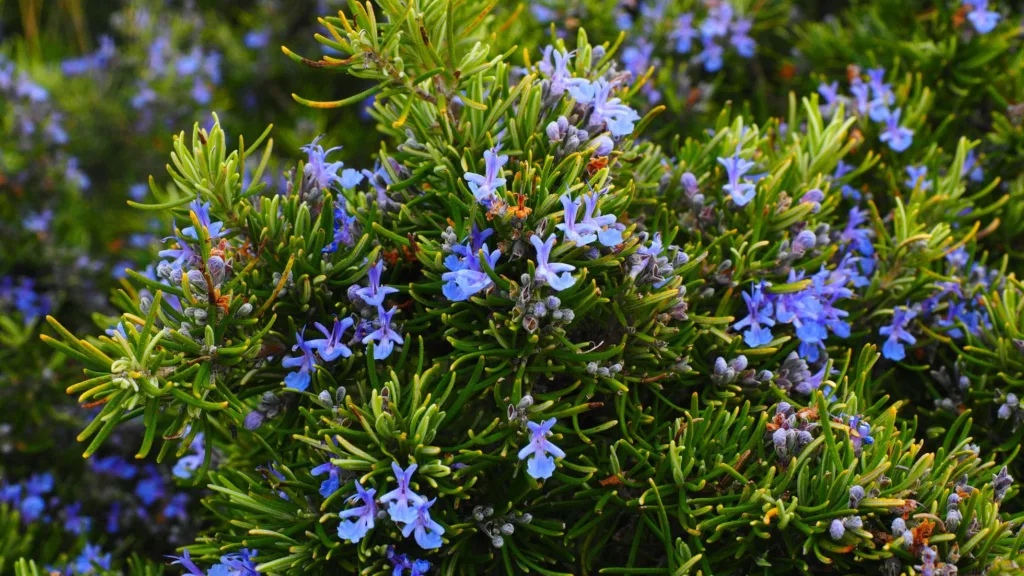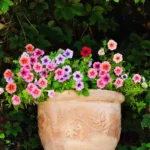Rosemary types
There are many varieties of rosemary out there, but they can be generally grouped into a few categories based on their growth habit:
- Upright rosemary: These are the most common type, and they grow into bushy shrubs. Some popular upright varieties include ‘Tuscan Blue,’ ‘Miss Jessop’s Upright,’ and ‘Spice Island.’
- Trailing rosemary: These rosemary plants tend to cascade over edges or sprawl along the ground. They’re great for hanging baskets or softening garden edges. ‘Santa Barbara’ and ‘Huntington Carpet’ are two well-known trailing varieties.
- Prostrate rosemary: These hug the ground even more than trailing rosemary, forming a dense mat. Prostrate rosemary is a good choice for covering slopes or filling in gaps between paving stones.
Besides growth habit, rosemary varieties can also differ in:
- Flower color: Rosemary flowers typically bloom in shades of blue, but there are also pink and white varieties.
- Leaf color: Most rosemary has green foliage, but some have variegated leaves with gold or white markings.
- Aroma: The intensity of the rosemary scent can vary between varieties.

Rosemary seeds
Growing rosemary from seeds is a rewarding experience. Here’s a simple guide:
- Collect Seeds: Obtain rosemary seeds from a reliable source or collect them from an existing plant. Wait until the base of the plant turns brown and starts to dry out, then gently pull the seeds off.
- Germination: Rosemary seeds can be tricky to germinate. Sow them indoors in a warm room (65-70°F) about ten weeks before the last frost. Be patient, as only about one in four seeds will succeed.
- Growing Conditions: Provide full sun (6-8 hours daily) and use well-drained soil. Remember, patience pays off when growing rosemary from seeds!
Rosemary leaves
Rosemary (Rosmarinus officinalis) is a fragrant herb commonly used in cooking and for its medicinal properties. Here’s some information about it:
- Care and Cultivation:
- Light: Rosemary prefers full sun (at least 6 hours of direct sunlight per day).
- Soil: Well-draining soil with good aeration.
- Watering: Let the soil dry between waterings. Avoid overwatering.
- Temperature: Hardy in zones 8-10. Protect from frost.
- Pruning: Pruning regularly helps to retain form and promote bushier growth.
- Propagation: Rosemary can be propagated from cuttings.
- Benefits:
- Culinary Use: Rosemary adds flavor to roasted meats, stews, and bread.
- Medicinal Properties: Medicinal benefits include antioxidant and anti-inflammatory effects.
- Aromatherapy: The scent of rosemary is invigorating and uplifting.
- Disadvantages:
- Pests: Aphids and spider mites may cause problems.
- Overwatering: Rosemary dislikes soggy soil.
Rosemary uses
Here are some common uses of Rosemary (Rosmarinus officinalis):
- Culinary: Rosemary is a popular herb in cooking. Its aromatic leaves add flavor to roasted meats, stews, and bread. You may use both fresh and dried rosemary.
- Medicinal Properties:
- Antioxidant: Rosemary contains compounds with antioxidant properties.
- Anti-Inflammatory: It may help reduce inflammation.
- Aromatherapy: The invigorating scent of rosemary is used in aromatherapy to improve focus and mental clarity.
- Hair Care: Rosemary-infused oil is believed to promote hair growth and improve scalp health.
- Skin Care: Rosemary extracts are used in skin care products for their antimicrobial and toning effects.
- Garden Pest Repellent: Planting rosemary near other plants can help repel certain pests.
Rosemary plant in India
Rosemary (Salvia rosmarinus), known as “Gulmehandi” in Hindi, is a fragrant and evergreen herb.
Rosemary plant in other languages
Rosemary has many names worldwide, reflecting its long history and widespread cultivation. Here are a few examples:
- Spanish: Romero
- French: Romarin
- German: Rosmarin
- Italian: Rosmarino
- Portuguese: Alecrim
- Dutch: Rozemarijn
- Russian: Розмарин (Rozmarin)
- Chinese (Simplified): 迷迭香 (Mí dié xiāng)
- Japanese: ローズマリー (Rōzumarii)
- Korean: 로즈마리 (Rojeumari)
- Arabic: إكليل الجبل (Iklil al-jabal)
- Turkish: Biberiye
- Greek: Δεντρολίβανο (Dendrolívano)
- Hebrew: רוזמרין (Rozmarin)
- Hindi: रोज़मेरी (Rōzmērī)
- Swedish: Rosmarin
- Danish: Rosmarin
- Finnish: Rosmariini
- Norwegian: Rosmarin
- Telugu: రోస్మరీ (Rōsmarī)
- Kannada: ರೋಸ್ಮೆರೀ (Rōsmerī)
- Tamil: ரோஸ்மேரி (Rōsmēri)





